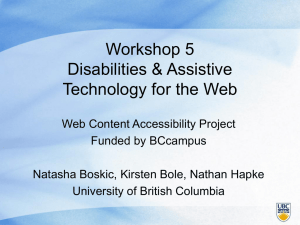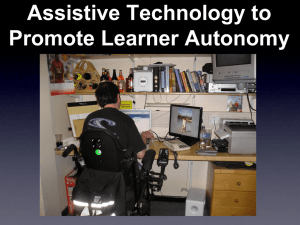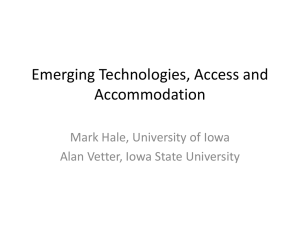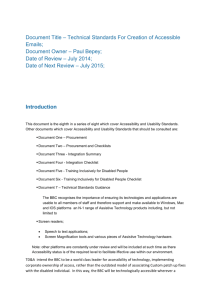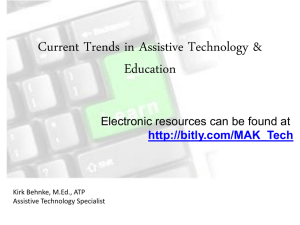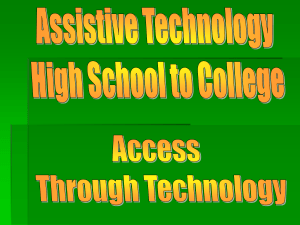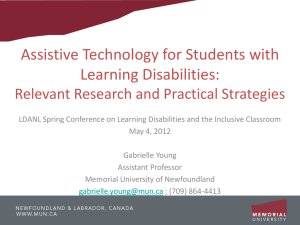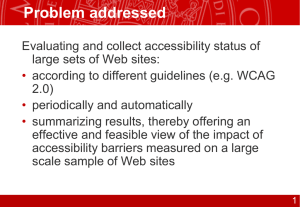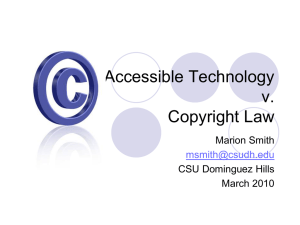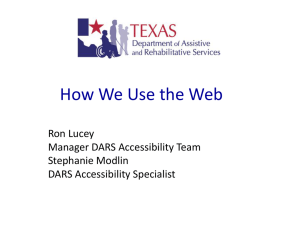Using Assistive Technologies to Access Instructional Materials
advertisement
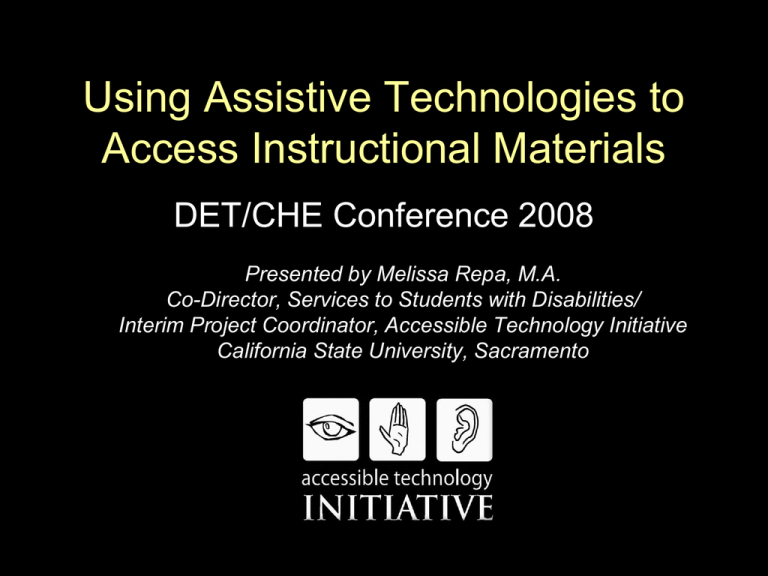
Using Assistive Technologies to Access Instructional Materials DET/CHE Conference 2008 Presented by Melissa Repa, M.A. Co-Director, Services to Students with Disabilities/ Interim Project Coordinator, Accessible Technology Initiative California State University, Sacramento Presentation Learning Objectives Participants will be able to: • Identify some of the assistive technologies used by students with disabilities to access instructional materials in alternative formats • Explore how assistive technologies and instructional materials accessibility can benefit learners and improve learning • Learn about the collaboration and use of resources involved in providing access to instructional materials Accessible Technology Initiative 2 Background: CSU Accessible Technology Initiative To assist CSU campuses with the implementation of Executive Order 926, Disability Support and Accommodations http://www.calstate.edu/EO/EO-926.html “It is the policy of the CSU to make information technology resources and services accessible to all CSU students, faculty, staff and the general public regardless of disability.” Accessible Technology Initiative 3 Assistive Technology & Accessibility Assistive Technology: “products, devices or equipment… that are used to maintain, increase or improve the functional capabilities of individuals with disabilities...” (Assistive Technology Act) Accessibility: “enabling IT hardware, software and services to be used effectively by people with disabilities.” (Mary Cheng, former Director of CSU ATI) Complementary but different – both are necessary Accessible Technology Initiative 4 Assistive Technology Demonstrations Screen readers are software programs that present the screen and text as speech. Screen magnifiers are programs that allow the user to enlarge everything on the screen Scan/read software scans information to the screen and “reads" it aloud with text-to-speech Alternative input devices allow individuals to control computers through means other than a standard keyboard or mouse. Alternative formats include Braille, large print, digital text file, MP3, or audio recording. Accessible Technology Initiative 5 JAWS Screen Reader JAWS Screen reader http://www.freedomscientific.com Accessible Technology Initiative 6 ZoomText Screen Magnifier Zoomtext Screen magnifier http://www.aisquared.com Accessible Technology Initiative 7 Kurzweil Scan/Read Kurzweil Scan/Read software http://www.kurzweil.edu Accessible Technology Initiative 8 Alternative Input Devices On Screen Keyboard, Microsoft Accessibility – http://www.microsoft.com/enable Accessible Technology Initiative 9 Limitations of Assistive Technology Web sites, online instruction are unusable with assistive technologies if not developed with accessibility in mind – What if the web page content is only accessible by using a mouse? What would students do if they use assistive technologies or can't use a mouse? – What if the software uses all graphics instead of text? If screen readers can only read text, how would students using screen readers read the graphics? – What if an online quiz is timed? What would students do if they needed extra time to use assistive devices? Accessible Technology Initiative 10 Accessibility Benefits Many 60% of working-age adults (18 to 64 years old) are likely to benefit from the use of accessible technology (http://www.microsoft.com/enable/research/workingage.aspx) “Technologies such as voice recognition, wireless communications and speech output improve the ability to access IT for those who have disabilities and are also increasingly in demand by today's society seeking convenience and ease of use.” (http://www-306.ibm.com/able/access_ibm/qa.html) Accessible Technology Initiative 11 Leveraging Accessibility to Improve Learning • Multiple means of representation • Multiple means of expression • Multiple means of assessment Universal Design pedagogical concepts Accessible Technology Initiative 12 Leveraging Accessibility to Improve Performance • Accessible technology can increase usability and effectiveness of the tools and thereby can improve performance of students Example: accessible electronic text increases ability to search text Accessible Technology Initiative 13 Accessible Media Production 3. Student Obtains List of Materials from Bookstore and Faculty 4. Staff Request Electronic Files from Publisher, Faculty, or Repositories 5. If Files Are Not Available, Staff Scan Pages One by One 6. Staff Edit & Reformat Each Page 7. Staff Convert Files to Other Formats Accessible Technology Initiative Time Intensive Process 1. Student Applies to Office of Services to Students with Disabilities 2. SSWD Staff Determine Appropriate Alternative Media (e.g. E-Text, Braille) 14 Accessible Technology: A Team Approach Bookstore Academic Technology Information Technology Library Students Publishers Services to Students with Disabilities Accessible Technology Initiative TEAM Approach: Various units working together no one team member can act as the single agent for providing accessible instructional materials 15 Resources • Accessibility at Sacramento State http://www.csus.edu/accessibility • High Tech Center at Sacramento State http://www.csus.edu/sswd/services/htc.html • CSU Accessible Technology Initiative http://www.calstate.edu/accessibility • National Center on Accessible Information Technology in Education (Access IT) http://www.washington.edu/accessit/index.php Accessible Technology Initiative 16 Recap & Questions We Aimed To: • Identify some of the assistive technologies used by students with disabilities to access instructional materials in alternative formats • Explore how assistive technologies and instructional materials accessibility can benefit learners and improve learning • Learn about the collaboration and use of resources involved in providing access to instructional materials Questions and Comments? Accessible Technology Initiative 17 Contact Information Melissa Repa, M.A. Services to Students with Disabilities California State University, Sacramento 6000 J Street, Sacramento, CA 95819-6042 E-mail: repam@csus.edu Voice: 916-278-7821 Fax: 916-278-7825 Accessible Technology Initiative 18
